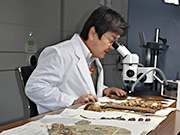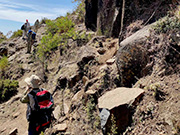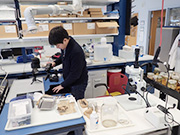
Research
In the National Museum of Nature and Science, we conduct a continuous program of empirical research on the evolution of the earth and life and the development of science and technology from the perspectives of natural history and the history of science and technology. We make available the results of our researches, as well as the extensive collection of specimens and materials that support them, to future generations.
We also aim to return to society the fruits of our research, exhibiting it and undertaking educational activities that foster greater understanding of the earthís environment and developments in science and technology, stimulating thought and discourse about future directions for humanity and the earth.
We also aim to return to society the fruits of our research, exhibiting it and undertaking educational activities that foster greater understanding of the earthís environment and developments in science and technology, stimulating thought and discourse about future directions for humanity and the earth.
Research at the National Museum of Nature and Science

Consulting plant specimens
in the herbarium

Geological survey of continental
flood basalt in Ethiopia
Our research work falls into two broad categories: basic research and integrated research. Basic research consists of programs of continuous, empirical research. This research is guided by themes determined in each research group and department and based on the Museumís collections. Integrated research is conducted with set deadlines and interdisciplinary themes, focusing on vital issues from the latest trends in research. Currently four research programs are in progress at the Museum.
Integrated research
- The Natural History Research Network of Myanmar and the foundation of an International Research Center
- Adaptive trends, evolution, and modeling of organisms to respond natural and artificial environments
- A study of biota changes in urban environments over the past 150 years - Analysis of specimens collected mainly from the Imperial Palace in central Tokyo
- Integrated research on extreme environments
Training the Next Generation

Graduate student working
in Natural Museum of Natural History,
Smithsonian Institute
In addition, the Museum is accepting postdoctoral researchers from the Japan Society for the Promotion of Science and is creating its own independent research-fellow system. Through measures such as these, the National Museum of Nature and Science is taking proactive steps to train the researchers of tomorrow.